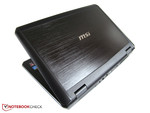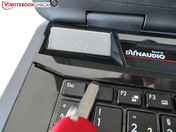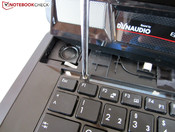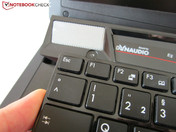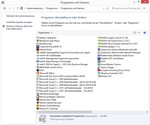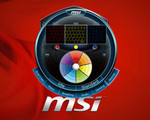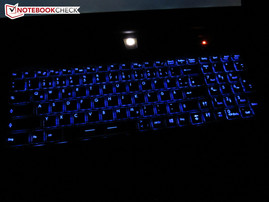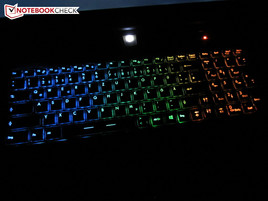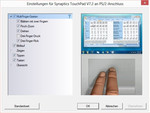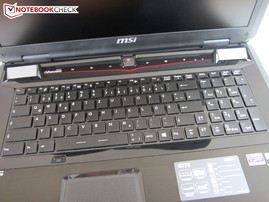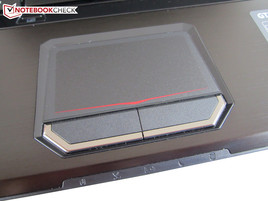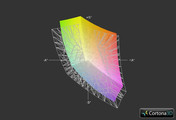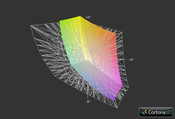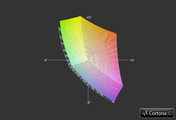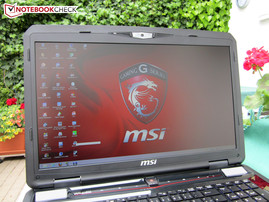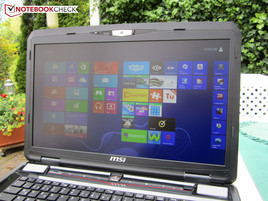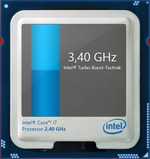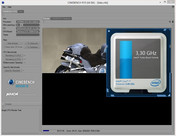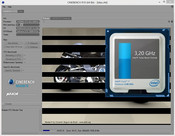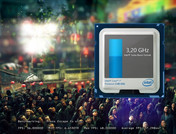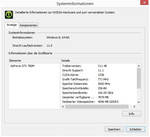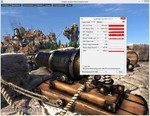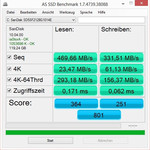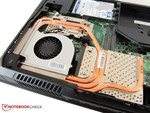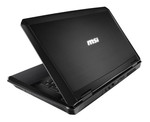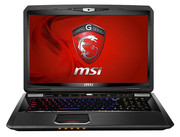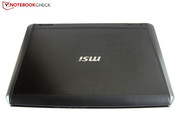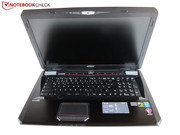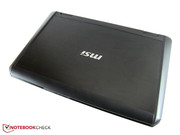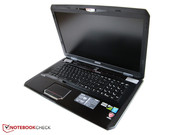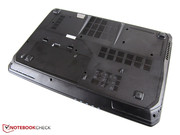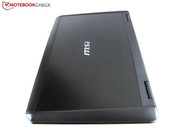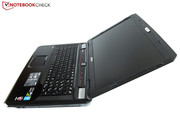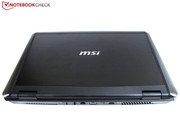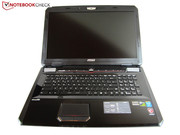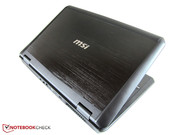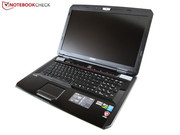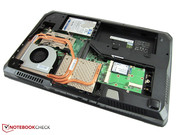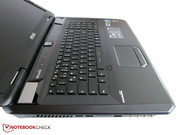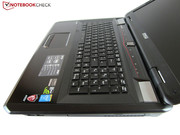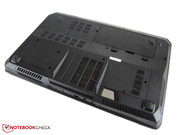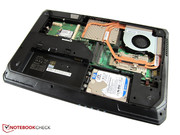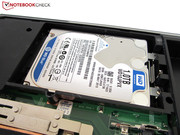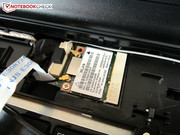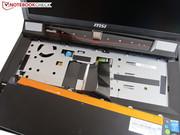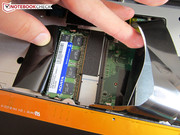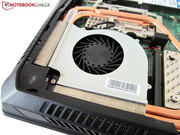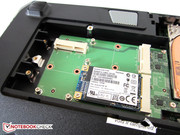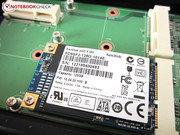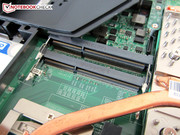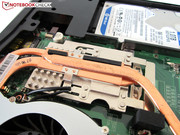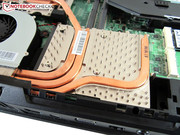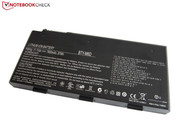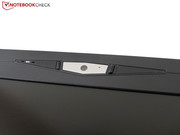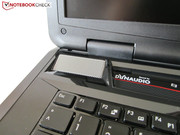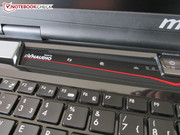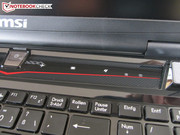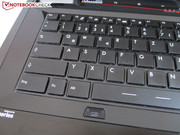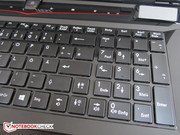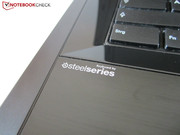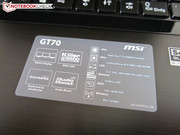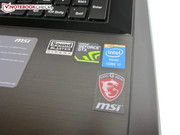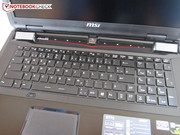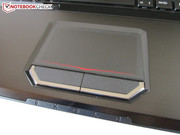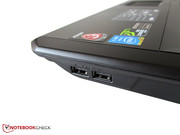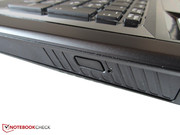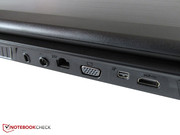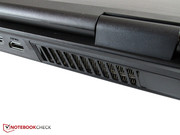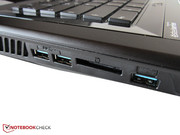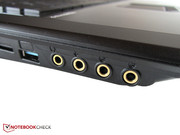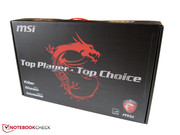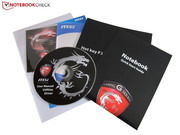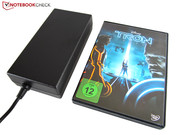Review MSI GT70H-80M4811B Notebook
For the original German review, see here.
Unsurprisingly, MSI offers the 17-inch device in several versions that strongly differ in price. The lower end is occupied by the GT70-70M387B, which features a swift 2.4-3.4 GHz Core i7-4700MQ, 8 GB of DDR3 RAM, a large 750 GB HDD and a Blu-ray combo. The manufacturer installs Nvidia's brand new GeForce GTX 770M for graphics. Its price: 1500 Euros (~$1982).
The 100 Euros (~$132) more expensive GT70H-70M3811B, which also features a Core i7-4700MQ, a GeForce GTX 770M and Blu-ray drive, is delivered with a large 1000 GB HDD and a small 128 GB mSATA SSD. For 200 Euros (~$264) more, the buyer gets the GT70PH-70M3827B. This model is identical to the cheaper version, apart from the hard drive configuration (2x 128 GB mSATA SSD + 750 GB HDD).
However, it first gets really interesting with the GT70H-80M4811B that MSI sent us for testing. It is currently sold for around 2000 Euros (~$2643). In addition to 8 GB of DDR3 RAM, a Blu-ray drive and a combination of a small 128 GB mSATA SSD and big 1000 GB HDD, it sports a GeForce GTX 780M. Nvidia's new top-of-the-range model is targeted at demanding gaming fans. The Core i7-4700QM is installed here as well.
Even more lush, but also considerably more expensive, is the GT70SR2-80M41637BW(R). The buyer not only gets 16 GB DDR3 RAM and a Blu-ray burner, it also features three mSATA SSD with a capacity of 128 GB each and a large 750 GB HDD for a steep 2700 Euros (~$3568). This is complemented with a Core i7-4760MQ and GeForce GTX 780M.
We would not recommend the 3700 Euros (~$4890) GT70SR2-x80M43237BW(R) premium model because the faster Core i7-4930MX processor and the fatter storage capacity of 32 GB DDR3 RAM does not really justify the tremendous surcharge. Our two favorites are the GT70H-80M4811B and the GT70H-70M3811B.
| GT70SR2-x80M43237BW(R) | GT70SR2- 80M41637BW(R) | GT70H-80M4811B | GT70PH-70M3827B | GT70H-70M3811B | GT70-70M387B |
|---|---|---|---|---|---|
| Core i7-4930MX | Core i7-4700MQ | Core i7-4700MQ | Core i7-4700MQ | Core i7-4700MQ | Core i7-4700MQ |
| GeForce GTX 780M | GeForce GTX 780M | GeForce GTX 780M | GeForce GTX 770M | GeForce GTX 770M | GeForce GTX 770M |
| 32 GB DDR III | 16 GB DDR III | 8 GB DDR III | 8 GB DDR III | 8 GB DDR III | 8 GB DDR III |
| 3x 128 GB SSD + 750 GB HDD | 3x 128 GB SSD + 750 GB HDD | 128 GB SSD + 1.000 GB HDD | 2x 128 GByte SSD + 750 GB HDD | 128 GB SSD + 1.000 GB HDD | 750 GB HDD |
| Blu-ray burner | Blu-ray burner | Blu-ray combo | Blu-ray combo | Blu-ray combo | Blu-ray combo |
| Full HD matte | Full HD matte | Full HD matte | Full HD matte | Full HD matte | Full HD matte |
| Windows 8 64-bit | Windows 8 64-bit | Windows 8 64-bit | Windows 8 64-bit | Windows 8 64-bit | Windows 8 64-bit |
| 3700 Euros (~$4890) | 2700 Euros (~$3568) | 2000 Euros (~$2643) | 1800 Euros (~$2379) | 1600 Euros (~$2114) | 1500 Euros (~$1982) |
Case
The case is based on the heavy 3.8 kilogram MS-1763 barebone. Compared with the MS-1762 precursor, its looks have not changed much. The manufacturer again relies on a mix of brushed aluminum for the lid and wrist rest and plastic.
While the display bezel is now finally matte, the keyboard rim still features a glossy finish. As known from high-gloss surfaces, fingerprints and dust accumulate very soon. The Asian manufacturer apparently does not believe in matte and thus insensitive surfaces. The design makes a rather ragtag and garish impression in general. It lacks a straightforward line.
Not every gamer will appreciate the bulky build either. 428 x 288 x 60 millimeters is big even in the 17-inch category. The competing Clevo P170SM barebone (One K73-3N) and P177SM barebone (Schenker XMG P703) are both a few millimeters thinner. Transporting the device alongside the 180 watt power supply (16.7 x 8.3 x 4.0 centimeters) will not really be convenient. The GT70 was clearly designed for stationary use.
The advantage of the casing's bulky build is its decent stiffness. Although the base unit yields easily in some places (keyboard, fan grille), the 17-incher averagely does a better job than most contenders on the whole.
The workmanship and material impression range on the standard gaming level; thus they are neither cheap nor extremely high-end. The aforementioned Clevo barebones make an identical quality impression. The Asus G75V and Alienware M17x can still be considered to be the reference, at least in this category.
Connectivity
Interfaces
Although a few interfaces are placed a bit unfavorably and the user has to tilt their head to quite a degree in order to see the ports (protruding edge), we quite liked the connectivity.
The GT70 strikes with two USB 2.0 ports and three USB 3.0 ports as well as an RJ45 Gigabit LAN port, Kensington lock and SD card reader. The three video ports, i.e. HDMI, mini DisplayPort and VGA, are particularly praiseworthy. According to MSI, up to three monitors can be connected. When counting the laptop's screen, a scenario with four monitors should be possible. The manufacturer calls this technology "Matrix Display".
The 17-inch device also stands out from the competition with its audio jacks. While some gaming laptops only sport two jacks (e.g. Samsung's 700G7C), the GT70 features a total of four audio ports (headphone, microphone, line-in, line-out). Owners of a surround system can take delight in full-bodied surround sound (7.1 analog + S/PDIF).
The Taiwanese company has also considered headset users. MSI wants to extract the maximum from the system with gold-plated ports and the so-called Audio Boost Technology (integrated power amplifier). However, owners of FireWire and eSATA devices are neglected.
Communication
Products from Qualcomm take care of (wireless) communication. Both the Killer e2200 Gigabit Ethernet controller and the Killer Wireless-N 1202 module (Wi-Fi 802.11 a/b/g/n + Bluetooth 4.0) are specially made for gamers according to Qualcomm. They are to prioritize latency sensitive network traffic. Besides diverse information, the preinstalled Network Manager offers many setting options. The Wi-Fi module's range was average in the test.
Maintenance
The maintenance and upgrade options proved to be very multifarious. Virtually all components can be accessed when the seven screws are removed from the large base cover. While a 2.5-inch slot is a matter of course, three mSATA slots are extremely uncommon.
MSI also has to be praised for its sophisticated cooling construction. Although the graphics card and processor share one fan and heat pipe, they have a separated system. Exemplary: The fan, CPU and GPU can be removed when required.
MSI divided the RAM slots on both motherboard sides. The user has to remove the keyboard in order to reach the primary RAM banks. This sounds easier than it is because two screws on the casing's bottom and the speaker grille (which also conceals the wireless module) have to be removed before the five screws for the keyboard can be accessed. The latter proved to be quite unyielding even when a flat object and a lot of force was used. Lifting the keyboard was no problem owing to the easy clasps.
Software
Almost 40 programs and tools are installed in state of delivery. Besides the limited trial versions of Office 365 and Norton Internet Security, the buyer will find Windows Live Essentials 2012 and a tool for creating a system recovery, which is also available as a hidden partition. Owing to CyberLink's PowerDVD 10, the GT70 can play Blu-ray media without additional software. A few other programs, such as System Control Manager, can be found further below.
Accessories
The aforementioned 180 watt PSU and the just below 500 gram 9-cell battery are included alongside several information leaflets (quick start guide, warranty booklet, warranty card, etc.), a driver and a tool DVD as well as a dragon sticker for the laptop's lid.
Warranty
MSI promises a two-year pick-up & return service.
Input Devices
Keyboard
The chiclet keyboard was designed for gaming in collaboration with SteelSeries. Games are to be controlled perfectly due to a special arrangement of the WASD keys ("golden triangle"). The buyer has to decide whether this is true for them.
We do not inevitably deem the modifications to the standard layout as ideal because it needs more time getting used to. For example, MSI moved the <>| key, which is normally beside the left shift key, to the right beside the space bar. A single-rowed enter key (also applies to the German version and is the reason for a displaced # key) will also not suit everyone.
However, we would like to favorably highlight the four-column number pad and the cleverly distributed special functions. Why do other manufacturers not place the brightness and volume controls on the arrow keys? It is also possible to switch the screen and disable/enable the touchpad, webcam and wireless module via the F row.
A few touch-sensitive areas are again found between the speaker grilles. While the symbols in the left area are for PowerDVD 10, Cooler Boost technology (increases the fan speed in favor of temperature) and key lights, the right area starts plane mode, System Control Manager or turns off the screen.
Like the precursor, the laptop has an adjustable 3 zone lighting that enables setting the color manually. The easy to use software also provides several special modes, such as "Wave" or "Breathing". However, it is too bad that the illumination is not completely homogeneous (the left arrow key is a bit brighter than the others).
The keyboard makes a fairly good impression technically. However, the user should not expect it to be on a reference level. The typing mechanism and feedback are decent and a key size of 14.5 x 14.5 millimeters is also beyond reproach. Only the typing noise could be a bit more restrained.
Touchpad
The Synaptics V7.2 touchpad does a very decent job. The mouse replacement can always be located because it is lowered and it has a lightly roughened texture. In our opinion, the surface is a good compromise of feedback and gliding quality. However, the touchpad could be a bit bigger. A usable surface of 84 x 42 millimeters is not exactly generous in the 17-inch category.
However, the supported gestures i.e. scroll, zoom, rotate, compensate for this drawback. Apart from a few minor dropouts, most finger inputs are detected reliably. The accuracy is also decent. A nice idea from MSI is that the touchpad is automatically disabled when an external mouse is connected.
Display
The screen used in all GT70 models is identical. As is fitting for a modern premium laptop, MSI installs a low-reflection Full HD (1920x1080 pixels) screen. The same successful Chi Mei N173HGE-L11 screen as found in the precursor is used and which is known for its good image quality.
With an average brightness of 324 cd/m², the 17-incher even excels over the Clevo contenders, Schenker XMG P703 and One K73-3N (~290-300 cd/m²), which also use the Chi Mei N173HGE-L11. A rate of over 300 cd/m² is outstanding and indicates perfect outdoor suitability.
| |||||||||||||||||||||||||
Brightness Distribution: 85 %
Center on Battery: 345 cd/m²
Contrast: 932:1 (Black: 0.37 cd/m²)
62% AdobeRGB 1998 (Argyll 3D)
85.3% sRGB (Argyll 3D)
60.8% Display P3 (Argyll 3D)
The not quite immaculate illumination of ~85% and the minor backlight bleeding at the screen's edge are barely noticed in practice. Despite a slight tendency to gray (affects dark video and gaming scenes), we also found the black value of 0.37 cd/m² appealing. Cheaper screens do not achieve this rate.
The contrast proves to be the biggest highlight. While mainstream screens only manage about 300-500:1, the Chi Mei N173HGE-L11 achieves over 900:1. Most buyers will also be satisfied with the color reproduction. The suboptimal calibration and color space coverage will only be interesting for (semi-) professional users.
The screen's "coarse" finish is striking. However, it is not a flaw but a uniqueness of the Chi Mei N173HGE-L11.
The GT70 makes a good impression outdoors due to its first-rate brightness and the matte surface. The screenshots below clearly show this. The content remains legible even on brighter days.
Performance
Processor
A quad-core processor from Intel's Haswell generation powers the laptop. The Core-i7 4700MQ is built in a 22 nm process and, like the more expensive Core i7-4800MQ, has a 6 MB L3 cache.
The CPU can increase its default clock rate of 2.4 GHz up to 3.4 GHz via Turbo Boost technology. Hyper Threading simulates virtual cores. A maximum of eight parallel threads promise a long-term viability.
A big advantage of the new architecture is the much stronger graphics chip. The laptop can switch between the HD Graphics 4000 and the dedicated graphics card since it supports Nvidia's Optimus technology.
It is convenient that the power button always indicates whether Intel's GPU (white) or the GeForce (orange) is active. Nvidia's system control offers many options to customize Optimus (profiles, global settings, etc.).
Turbo Boost
We would like to take an in-depth look at the Turbo Boost technology. The automatic CPU overclocking works immaculately even under more difficult circumstances. An average of 3.3 GHz when one core is loaded and 3.2 GHz when all cores are loaded does not give reason for complaint. The Core i7-4700MQ clearly clocked over its default rate even in 3D operation (the third screenshot shows Hitman: Absolution). 3.0 GHz during full load is also impressive. In a nutshell, MSI seems to have done a decent job in this regard.
CPU Performance
When considering the pure CPU performance, Haswell can only set itself apart from the Ivy Bridge generation to a certain degree. For example, with 1.48 points the Core i7-4700MQ only supplied a 6% advantage over the former Core i7-3630QM (1.4 points @ MSI GT60 0NG-294US), which also clocks with 2.4-3.4 GHz.
The difference is just as low in the multi-CPU test. 6.86 vs. 6.41 points equal a plus of only 7%. But let's be honest, the Ivy Bridge generation had more than enough power for most applications. The processor should not turn out to be the limiting factor for some years.
| Cinebench R10 | |
| Rendering Single CPUs 64Bit (sort by value) | |
| Core i7-4700MQ | |
| Core i7-3630QM | |
| Core i7-4800MQ | |
| Rendering Multiple CPUs 64Bit (sort by value) | |
| Core i7-4700MQ | |
| Core i7-3630QM | |
| Core i7-4800MQ | |
Graphics Card
The GeForce 700M series is not a completely new architecture. It is mainly based on the technology of the former generation. Thus, the Kepler GPUs are still built in a 28 nm process.
The customer can choose between the two strongest members for the MSI GT70. These are the GeForce GTX 770 and the GeForce GTX 780M. While the GTX 780M comes with 1536 unified shaders and a 4096 MB GDDR5 video memory that clocks with 2500 MHz (256-bit interface), the GeForce GTX 770 only has 960 arithmetic units and a 3072 MB GDDR5 video memory with a clock rate of 2000 MHz (192-bit interface). The GTX 770M on-chip clock is also lower with 706 vs. 771 MHz.
Distinct increases are noticed when the old GeForce GTX 680M is compared with the GeForce GTX 780M. The former premium model (we exclude the GeForce GTX 680MX here) "only" offers 1344 CUDA cores, an on-chip clock of 720 MHz and a memory clock of 1800 MHz.
One of the most important features of the GeForce 700M series is the optimized overclocking function. Besides power consumption, the GPU Boost 2.0 now also considers the temperature. According to the GPU-Z tool, the on-chip clock climbed to a high 850 MHz in the Unigine Heaven benchmark.
Regrettably, the first batch of the GT70 has to work with the outdated ForceWare 311.48 GPU driver. Thus, the GeForce GTX 780M could only set itself apart from actually weaker graphics card to an extent in newer games like BioShock Infinite, which we tested with a new GPU driver.
Although the ForceWare 320.21 was available at the time of the tests, this version caused serious problems, e.g. black screen when switching to the desktop. At least we could run 3DMark 2013 and 3DMark 11 one time. The result was that the new driver partly boosted the performance considerably (+8% in 3DMark 2013).
GPU Performance
The GeForce GTX 780M is also impressive in DirectX 11 programs. For example, when we take the Unigine Heaven 3.0 benchmark (1920x1080, high, default tessellation), 72 fps equals an extremely smooth frame rate. It is just over 25% of the GeForce GTX 680M (57.6 fps @ Schenker XMG P502) and 45% higher than that of the GeForce GTX 770M (49.5 fps @ One K73-3N).
The performance in 3DMark's 2013 edition is just as impressive. With a GPU score of 5104 points, the GeForce GTX 780M takes an approximately 50% lead on the GTX 770M (3392 points) and 30% on the GTX 680M (3952 points) in the Fire Strike test.
| 3DMark 11 - 1280x720 Performance GPU (sort by value) | |
| GeForce GTX 780M | |
| GeForce GTX 770M | |
| GeForce GTX 680M | |
| Unigine Heaven 2.1 - 1280x1024 high, Tesselation (normal), DirectX11 AA:off AF:1x (sort by value) | |
| GeForce GTX 780M | |
| GeForce GTX 770M | |
| GeForce GTX 680M | |
| 3DMark 06 Standard Score | 22465 points | |
| 3DMark Vantage P Result | 25065 points | |
| 3DMark 11 Performance | 7127 points | |
| 3DMark Ice Storm Standard Score | 65537 points | |
| 3DMark Cloud Gate Standard Score | 17363 points | |
| 3DMark Fire Strike Score | 4631 points | |
Help | ||
Storage Devices
The GT70H-80M4811B that we tested is powered by a small 128 GB mSATA SSD and a large 1000 GB HDD. It quickly becomes clear that MSI makes no compromises here when looking at the benchmarks.
In contrast to the SSD RAID in the former GT70 (2x SanDisk U100), the solid state drive in the new model (SanDisk X100) scores with all file sizes. A sequential read speed of 470 MB/s and a sequential write rate of 332 MB/s are just as good as full-blown 128 GB models, such as the Samsung SSD 830. The SanDisk X100 does not exhibit any weaknesses in the access rates of 0.17 ms @ read and 0.06 ms @ write either. The operating system is booted swiftly owing to the SSD technology. Installations, data transfer and loading are also performed quickly.
MSI additionally installs a one terabyte Scorpio Blue HDD from Western Digital to ensure that the customer has enough storage for personal data. It spins at 5400 rpm. A sequential read and write rate of around 93 MB/s gives no reason for complaint, for an HDD.
System Performance
We can keep the part about system performance short. As expected, it is outstanding. With 20318 points in PCMark Vantage and 5310 points in PCMark 7, the 17-incher leaves most gaming contenders behind. For comparison, the former GT70 with a Core i7-3610QM and GeForce GTX 670M only accomplished 15075 and 4202 points (-25%/-20%).
| PCMark Vantage Result | 20318 points | |
| PCMark 7 Score | 5310 points | |
Help | ||
Gaming Performance
The graphics performance does not fall short anywhere. As can be seen in the chart below, the GeForce GTX 780M copes with almost all modern games in maximum details and 1920x1080 pixels. A two or four time MSAA anti-aliasing is usually no problem either.
The premium model only has difficulties with extremely computing-intensive tracks, such as Far Cry 3 or Crysis 3, which also still look very good in high details. The GeForce GTX 780M is also the only laptop GPU that surpassed 35 fps in the integrated benchmark in Metro: Last Light (ultra setting w/o SSAA) until now. The majority of the tested games ran with an average of over 40 fps.
We were surprised that the GT70 scored a bit lower than the One K56-3N2 and Schenker XMG P703 GTX 780M contenders in CPU-heavy games, such as F1 2012, Dirt: Showdown, Call of Duty: Black Ops 2, Assassin's Creed III and Skyrim. Both the processor's and graphic's Turbo were inconspicuous in "normal" 3D operation. Perhaps the Clevo laptops have a superior driver although the version number actually indicates the opposite (ForceWare 311.27 rather than 311.48).
The GeForce GTX 770 calculated roughly 25-30% slower throughout all benchmarks.
| low | med. | high | ultra | |
|---|---|---|---|---|
| Battlefield 3 (2011) | 47.5 | |||
| The Elder Scrolls V: Skyrim (2011) | 58.6 | |||
| Anno 2070 (2011) | 71.2 | |||
| Alan Wake (2012) | 52.3 | |||
| Risen 2: Dark Waters (2012) | 52.7 | |||
| Dirt Showdown (2012) | 54.4 | |||
| Sleeping Dogs (2012) | 30.6 | |||
| Guild Wars 2 (2012) | 41.3 | |||
| F1 2012 (2012) | 79 | |||
| Borderlands 2 (2012) | 82.1 | |||
| Need for Speed: Most Wanted (2012) | 57.6 | |||
| Call of Duty: Black Ops 2 (2012) | 84.2 | |||
| Hitman: Absolution (2012) | 34.4 | |||
| Assassin´s Creed III (2012) | 36.5 | |||
| Far Cry 3 (2012) | 29 | |||
| Crysis 3 (2013) | 27.9 | |||
| Tomb Raider (2013) | 64 | |||
| SimCity (2013) | 39.7 | |||
| BioShock Infinite (2013) | 43.7 | |||
| Metro: Last Light (2013) | 89.3 | 85 | 63.2 | 35 |
Emissions
System Noise
The noise development was one of the biggest, positive surprises. The MSI GT70 produced less noise than the Clevo P170SM and P177SM barebones in both idle as well as during load. This is particularly astonishing since the 17-incher only sports one fan.
While both gaming contenders attracted attention with approximately 36 dB in idle, the GT70 only reached 30-32 dB. Depending on the situation, the laptop was either only slightly audible or almost silent.
It took a long time until the fan jumped from 36 dB to a very audible but not yet distracting 41-43 dB in 3DMark06. Both Clevo devices were much louder with 46-47 dB. The GT70's full load noise level was also lower with 47 vs. 54-55 dB.
Generally, MSI scores with better fan management, which is more stable and not as sporadic. We would have counted with a higher noise considering the powerful GeForce GTX 780M graphics card.
Noise level
| Idle |
| 29.6 / 31.1 / 31.9 dB(A) |
| Load |
| 41.3 / 46.8 dB(A) |
 | ||
30 dB silent 40 dB(A) audible 50 dB(A) loud |
||
min: | ||
Temperature
Besides the noise emissions, the temperatures are also compelling. The casing's surfaces settle to an agreeably low 23 °C after two hours of idling. An average of 33 °C during full load is also pleasant. However, the chassis achieves up to 46 °C on the top and 49 °C on the bottom in the vent's area. It is possible to adequately enjoy games for several hours because the wrist rest remains cool with a maximum of 28 °C.
Although the graphics card and processor reach up to 90 °C in extreme cases, the hardware temperatures are still reasonable. The CPUID Hardware Monitor recorded 30 °C at the hard drives. We can only criticize the GeForce GTX 780M's clock behavior. The on-chip clock dropped to below 600 MHz during our unrealistic one-hour stress test via Furmark and Prime tools. The Clevo P177SM barebone exhibited a similar behavior.
All measurements were performed with disabled Cooler Boost technology.
(-) The maximum temperature on the upper side is 46.1 °C / 115 F, compared to the average of 40.4 °C / 105 F, ranging from 21.2 to 68.8 °C for the class Gaming.
(-) The bottom heats up to a maximum of 49 °C / 120 F, compared to the average of 43.3 °C / 110 F
(+) In idle usage, the average temperature for the upper side is 23.4 °C / 74 F, compared to the device average of 33.9 °C / 93 F.
(+) The palmrests and touchpad are cooler than skin temperature with a maximum of 27.9 °C / 82.2 F and are therefore cool to the touch.
(±) The average temperature of the palmrest area of similar devices was 28.9 °C / 84 F (+1 °C / 1.8 F).
Speakers
The 17-incher inherits one of the most vital advantages of MSI's gamers: the excellent sound quality. The 2.1 system from Dynaudio scores with a quite balanced sound that decently renders all pitches. The GT70 is largely exempt from fraying that is typical for laptops.
The built-in subwoofer supplies the best bass that can currently be found in the laptop sector. Owing to its very high maximum volume, the GT70 can perfectly fill even larger rooms with sound. However, the sound is a bit tinny and muddy when the user overdoes it with the settings.
The good audio quality is also due to the Sound Blaster Cinema technology. It adds more volume to the sound and thus lets it seem less muffled. The SBX Pro Studio option should always be active (is also used in the new Clevo barebones).
Users who do not have a high demand on the sound do not need external speakers. Even the expensive Alienware and Asus device do not manage to excel over the 2.1 system in the GT70.
Energy Management
Power Consumption
The power consumption is absolutely acceptable in view of the available graphics performance. With 8-25 watts, the laptop consumes a bit less power from the mains in idle than the P157SM barebone, which needs 18-27 watts alongside a Core i7-4700MQ and GeForce GTX 780M. The GT70 also proved to be a bit more energy-efficient in the first scene of 3DMark06 with 103 vs. 109 watts. The stress test is also in favor of MSI. 162 to 202 watts is a clear difference.
The Hybrid Power technology causes some confusion. We have not tested it (yet) for time reasons. Hybrid Power allegedly uses the battery to ensure the maximum performance and power stability. Malicious tongues could now say that MSI only uses the technology as an excuse for not including a stronger power supply unit. It is not up to us to judge that.
| Off / Standby | |
| Idle | |
| Load |
|
Key:
min: | |
Battery Runtime
The battery life is above-average for a premium laptop. Not every contender achieves almost 1.5 hours in Battery Eater's Classic test using maximum brightness and six hours in Battery Eater's Reader's test with minimum brightness (e.g. Toshiba Qosimo X870-119).
The GT70 benefits from the battery's high capacity in addition to the graphics switching (87 Wh, 7800 mAh). The battery mentioned in the review of the Clevo barebone is "only" specified with 77 Wh and 5200 mAh. Wireless browsing is possible for about five hours before the laptop has to be recharged. We unfortunately could not test the DVD playback runtime because our test device apparently had a defect Blu-ray combo.
Note: The gaming performance decreases by about 60% in battery mode.
Verdict
The 17-incher seamlessly follows in the footsteps of the GT70 series. Buyers looking for a compact, light and unobtrusive laptop will definitely not find anything by MSI. The bulky chassis is not really portable with a weight of 3.8 kilograms. The unusual design is also a matter of taste.
Hardcore gamers who crave an eye-catching and powerful desktop replacement can certainly take this device. Besides the matte, Full HD screen, the sound quality is also compelling. Only a few laptops offer an equally good sound.
The moderate emissions also have to be praised. Despite the high-performance hardware installed in the GT70, it does not get exceedingly warm or loud. The gaming laptop makes a decent to good impression in battery runtime, input devices and connectivity. We also count the maintenance-friendly innards as a pro. It allows quickly replacing various components (three mSATA slots). Convenient fan cleaning is not a matter of course either.
If we have to complain about something then it is the high price. Although the 17-incher features a Blu-ray drive, a 128 GB SSD and the currently fastest laptop GPU, a price of 2000 Euros (~$2643) is quite steep.





